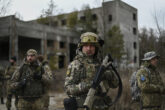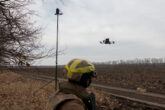March 30, 2018
A Balanced Defense
When President Trump signed the 2018 omnibus spending bill, he committed the nation to a two-year, $1.416 trillion defense-spending plan, but his signature did not answer the larger question that has been hanging over the defense debate: Should the nation invest in increased lethal capabilities — that is, more technical solutions such as stealth aircraft and more precise intelligence-surveillance-reconnaissance systems — or expand capacity, otherwise known as growing the force? The new national-security strategy issued by the White House in December and the national-defense strategy released by the Pentagon in January both endorse building capacity — increasing the number of personnel and ships, aircraft, and vehicles overall — as a strategic goal, although the Pentagon document is muted in its phrasing.
However, capabilities proponents, from both the right and the left, make arguments, from fiscal and technology perspectives, that it is no longer possible or necessary to maintain large numbers of troops, tanks, aircraft, and ships in the active force. They advocate instead a smaller but more lethal force centered around advanced capabilities. Voices from the expanded-capacity school argue that a generation of investment in exquisite capabilities has resulted in a diminished force that is too small to maintain the peace or win a war. They advocate significantly increased defense budgets, such as the one just approved, and a larger overall force that includes a bigger Army, Air Force, and Navy.
These approaches — increased capabilities and expanded capacity — appear greatly at odds with each other and draw on dissimilar assumptions regarding the global security environment. Each deserves an honest, objective examination. Is some balance between the two approaches possible?
Read the full article on National Review.
More from CNAS
-
Defense / Transatlantic Security
When Defense Becomes Destruction: Austria-Hungary’s Mistake and Ukraine’s RiskThis article was originally posted on War on the Rocks. The southeastern Polish city of Przemyśl, with its elegant 19th century Habsburg-era train station, remains one of the ...
By Franz-Stefan Gady
-
Defense / Transatlantic Security
Ukraine’s Catch-22 MomentThis article was originally published in the Financial Times. In Joseph Heller’s wartime classic, Catch-22, the protagonist Yossarian seeks out the US army surgeon Doc Daneeka...
By Franz-Stefan Gady
-
CNAS Insights | Budgetary Own Goals Undermine “Speed and Volume”
On November 7, Secretary of Defense Pete Hegseth laid out a plan to overhaul the Department of Defense’s (DOD’s) acquisition system. Placing an emphasis on delivering new capa...
By Philip Sheers, Carlton Haelig & Stacie Pettyjohn
-
Drones: Who Is Making the New Weapons of War?
From Ukraine and Russia to Gaza and Sudan, drones have become a key weapon of war. Which companies are making them, and profiting from this rapidly expanding but controversial...
By Stacie Pettyjohn




